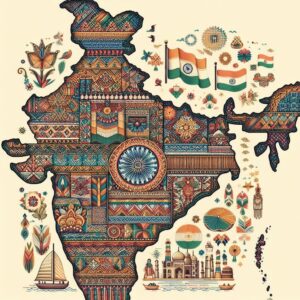
A tribute to the threads that built a nation.
Across India, every region has its own story—told not just in language or food, but in fabric. The loom is the storyteller, and every weave holds within it centuries of wisdom, tradition, and identity. But this story is fading, threatened by fast fashion, industrialization, and fading interest from the next generation. Before it’s too late, let’s journey across the subcontinent to rediscover the woven wonders of India — and why they must be preserved.
North India: Elegance in Every Thread
- Banarasi Silk (Uttar Pradesh): Rich brocade woven with gold and silver zari. Once favoured by Mughal royalty.
- Chikankari (Lucknow, UP): Delicate hand embroidery on fine muslin or cotton.
- Phulkari (Punjab): Vibrant floral embroidery on handwoven khaddar.
- Pashmina (Kashmir): Luxuriously soft wool, hand-spun from mountain goat wool and handwoven into shawls.
- Kullu & Kinnauri Shawls (Himachal Pradesh): Known for their intricate geometric patterns and vibrant borders.
- Jamdani (Varanasi): Originally from Bengal but woven in parts of UP too; delicate motifs woven into fine muslin.
East India: Whispering Weaves of Legacy
- Baluchari (West Bengal): Mythological tales woven into rich silk sarees.
- Tant (West Bengal): Everyday comfort in crisp, airy cottons with ornate borders.
- Kantha (West Bengal & Bangladesh): Quilting embroidery from recycled saris, now popular in sarees and scarves.
- Bomkai (Odisha): Tribal motifs and temple-inspired borders on cotton or silk.
- Sambalpuri Ikat (Odisha): Intricately dyed warp and weft threads, rich in symbolism.
- Dhalapathar Parda & Fabrics (Odisha): Rare, artistic curtain weaves made on wooden looms.
West India: Earthy Roots & Royal Flourish
- Bandhani (Gujarat & Rajasthan): Tie-dye craft with thousands of miniscule dots creating patterns.
- Ajrakh (Kutch, Gujarat): Ancient block-printing technique using natural dyes, often on handwoven fabric.
- Patola (Gujarat): Double ikat weave — one of the most complex and time-consuming techniques in the world.
- Mashru (Gujarat): Blend of cotton and silk, created for Muslim men who couldn’t wear pure silk.
- Paithani (Maharashtra): Royal silk sarees with peacock and lotus motifs woven with real gold threads.
- Himroo (Aurangabad, Maharashtra): Inspired by Persian designs, using cotton and silk blend.
South India: Timeless Grace on the Loom
- Kanjeevaram (Tamil Nadu): Rich silk sarees known for temple borders and golden zari.
- Chettinad Cotton (Tamil Nadu): Striking checks and vibrant color combinations in handwoven cotton.
- Ilkal (Karnataka): Cotton body with contrasting silk pallu, known for the ‘tope teni’ technique.
- Kasavu (Kerala): Off-white cotton sarees with gold borders, worn especially during festivals.
- Pochampally Ikat (Telangana): Geometric ikat patterns in bright colors, known globally.
- Venkatagiri (Andhra Pradesh): Lightweight sarees with zari, ideal for summer elegance.
- Mangalgiri (Andhra Pradesh): Striped or solid sarees woven on pit looms, known for their shine.
Central India: Tribes, Textures & Tradition
- Chanderi (Madhya Pradesh): Sheer, glossy fabric, often with nature-inspired motifs.
- Maheshwari (Madhya Pradesh): Silken cotton with zari borders and reversible pallus.
- Baiga & Gond Weaves (MP/Chhattisgarh): Tribal art-inspired designs now revived through textiles.
- Kosa Silk (Chhattisgarh): Wild silk with a textured, earthy look — a regional treasure.
Northeast India: Nature on the Loom
- Eri Silk (Assam & Meghalaya): Also called ‘Ahimsa silk’ — harvested without harming the worm.
- Muga Silk (Assam): Golden-yellow silk, exclusive to Assam, known for its natural sheen.
- Gamusa (Assam): Woven cotton cloth with red patterns — symbol of Assamese culture.
- Naga Textiles (Nagaland): Woven wool with tribal symbols and geometric motifs.
- Mizo & Manipuri Weaves: Bright stripes and traditional wraparounds made from natural fibers.
Why These Weaves Matter
Each of these textiles is not just beautiful — it’s sustainable, meaningful, and irreplaceable. They support rural economies, tell stories of identity and migration, and reflect deep connections to nature and spirituality. Losing these crafts would mean losing centuries of art and knowledge.
How You Can Help
- Buy handloom, not just for occasions, but for everyday use.
- Support government-certified handloom stores, exhibitions, and NGOs.
- Share artisans’ work on social media.
- Educate children about traditional crafts.
- Gift a handloom during weddings, birthdays, or festivals.
In the End, It’s Not Just a Saree
It’s a grandmother’s prayer, a mother’s legacy, a craftsman’s devotion, and a nation’s identity — all spun into six yards (or more) of wonder.
Let’s not let this heritage unravel.
Let’s wear our roots.
Let’s preserve the art of weaving — one thread at a time.
The fabric of India’s identity is woven with heritage, skill, and pride. Let’s not let it unravel. Let’s celebrate the weavers, the threads, and the timeless charm of the handloom — before it becomes a forgotten chapter in our history books.
Because when we wear a handloom, we wear a story.
Blogchatter A2Z powers this post.
Neerja Bhatnagar
Feel free to connect with me on social media to stay updated on more content like this!
Instagram | Facebook | YouTube |Twitter |Podcast |
I have written 3 solo books and 3 anthologies. You can buy my books on Amazon. If you are on Kindle Unlimited, you can read them for free. Pls, do check and share your reviews.
